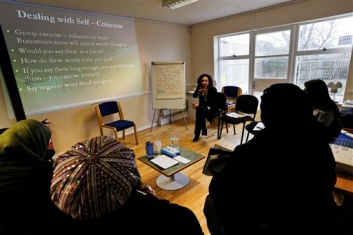
Powerpoints have become more important than class participation. Lefteris Pitarakis/AP
By Kristen Santer
The rise of technology has led teachers to lecture through the use of PowerPoint in classrooms, especially for courses that need to cover a lot of detail-orientated information. PowerPoint is most helpful in colleges with large class sizes, especially for remedial courses. However, in universities like Fordham with small professor-to-student ratios, PowerPoint can be superfluous.
There are many positive aspects to PowerPoint including its portability, ability to incorporate different kinds of media and its universal accessibility.
Although PowerPoint has advantages, its increased use often discourages interaction between students and professors, while causing students to lose focus during the class.
Information-heavy courses can cause professors to overload slides and move too quickly through the information without allowing students to fully engage in the classroom. Most professors also share the PowerPoint slides with students after the class. While this is valuable to those who have missed class, it often causes students to stop paying attention to the class altogether. Note taking no longer serves as a motivation to pay attention. Notes written and organized by the professor are available to students, diminishing attentiveness.
Many times, I find myself drifting away from the lectures since I know all the information for the test will be available on Blackboard. Sometimes, I learn new information nights before the test as I go through the PowerPoints that are usually crammed with details. This teaching technique questions the role of professors and the necessity of classroom attendance. Going to class seems like a hassle and an inconvenience if I could simply learn the information at home. In addition, the money spent on textbooks for the classes are a waste as well, for all of the information needed is on the PowerPoints. From several of my classes, the textbook is used only sporadically or never at all, if the class focuses on PowerPoints.
I find that classes I enjoy the most are those that involve more student engagement. Fordham necessitates through Eloquentia Perfecta (EP) courses. EP classes are designed to engage students’ verbal and written skills and to foster debate and conversation. These courses rarely use PowerPoint and focus more on the importance of inter-student and professor communication. I am not suggesting that the use of PowerPoints should be completely eliminated, but professors need to find a balance between PowerPoints and classroom engagement.
There are several ideas that are circulating through colleges that seem like they could encourage student involvement again. One suggested technique that has merit suggests that professors gather anonymous responses from the students by giving them access to PowerPoints during class with their own clickers. Professors can take attendance and give students questionnaires in order to foster class participation.
PowerPoint is only a tool that will improve student learning; professors should not rely on it and make it the focus of their class. Professors need to strategically employ it in ways that will encourage learning and involvement instead of hindering it. An increase in creativity and a change in structure can make an improvement in classroom dynamics. Professors should be the first source of information in courses, not the PowerPoints.
